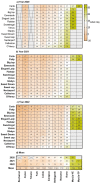Impact of Chill and Heat Exposures under Diverse Climatic Conditions on Peach and Nectarine Flowering Phenology
- PMID: 36771670
- PMCID: PMC9918920
- DOI: 10.3390/plants12030584
Impact of Chill and Heat Exposures under Diverse Climatic Conditions on Peach and Nectarine Flowering Phenology
Abstract
The present study aims to generalize cultivar-specific tree phenology responses to winter and spring temperatures and assess the effectiveness of the Tabuenca test and various chill and heat accumulation models in predicting bloom dates for a wide range of climatic conditions and years. To this end, we estimated the dates of rest completion and blooming and correlated them with observed bloom dates for 14 peach and nectarine cultivars that were evaluated in 11 locations across Europe (Greece, France, Italy, Romania and Spain), within the EUFRIN cultivar testing trial network. Chill accumulation varied considerably among the studied sites, ranging from 45 Chill Portions (CP) in Murcia-Torre Pacheco (Spain) to 97-98 CP in Cuneo (Italy) and Bucharest (Romania). Rest completion occurred latest or was not achieved at all for some cultivars in the southern sites in Murcia. Dormancy release happened earliest in Bucharest and Cuneo, sites where heat accumulation had a strong influence on the regulation of bloom time. Blooming occurred earliest in the moderately cold regions of Lleida (Spain) and Bellegarde (France), and 7-11 days later in the warmer locations of Rome (Italy) and Naoussa (Greece), suggesting that bloom timing is strongly influenced by delayed rest completion in these locations. The Dynamic Model resulted in both more homogeneous chill accumulation across years and better predictions of bloom dates, compared with the Utah, Positive Utah and Chilling Hours models. Prediction of bloom dates was less successful for low-chill cultivars than for medium- and high-chill cultivars. Further climatic and experimental data are needed to make estimates of the climatic needs of peach cultivars more robust and to generate reliable advice for enhancing the resilience of peach production under varying and changing climatic conditions.
Keywords: Prunus persica; chilling requirement; heat requirement; resilience.
Conflict of interest statement
The authors declare no conflict of interest.
Figures






References
-
- Cantin C.M., Wang X.W., Almira M., Arús P., Eduardo I. Inheritance and QTL analysis of chilling and heat requirements for flowering in an interspecific almond x peach (Texas x Earlygold) F2 population. Euphytica. 2020;216:51. doi: 10.1007/s10681-020-02588-9. - DOI
-
- Fadón E., Herrera S., Guerrero B.I., Guerra M.E., Rodrigo J. Chilling and Heat Requirements of Temperate Stone Fruit Trees (Prunus sp.) Agronomy. 2020;10:409. doi: 10.3390/agronomy10030409. - DOI
-
- Li Y., Fang W.C., Zhu G.R., Cao K., Chen C.W., Wang X.W., Wang L.R. Accumulated chilling hours during endodormancy impact blooming and fruit shape development in peach (Prunus persica L.) J. Integr. Agric. 2016;15:1267–1274. doi: 10.1016/S2095-3119(16)61374-6. - DOI
-
- Pawasut A., Fujishige N., Yamane K., Yamaki Y., Honjo H. Relationships between chilling and heat requirement for flowering in ornamental peaches. J. Jpn. Soc. Hort. Sci. 2004;73:519–523. doi: 10.2503/jjshs.73.519. - DOI
-
- Ruiz D., Campoy J.A., Egea J. Chilling and heat requirements of apricot cultivars for flowering. Environ. Exp. Bot. 2007;61:254–263. doi: 10.1016/j.envexpbot.2007.06.008. - DOI
Grants and funding
LinkOut - more resources
Full Text Sources
Miscellaneous

